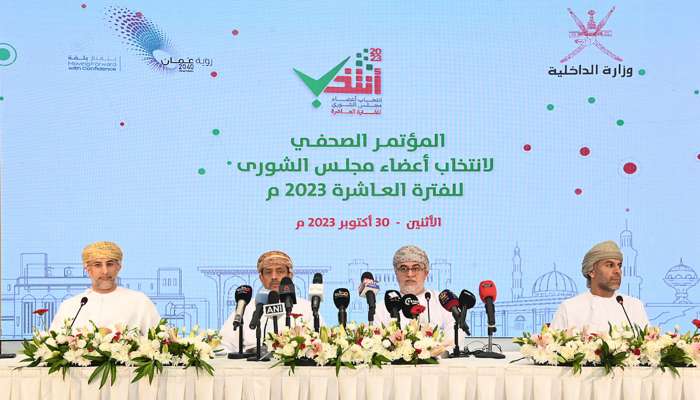
MUSCAT: Voters preference for new candidates was underscored during the elections of the tenth term of Shura Council as a whopping 64 percent new candidates were elected on Sunday.
A total of 90 members were elected from a pool of 843 candidates, which included 32 women. However, the tenth term election failed to elect any women members to the Shura Council.
The high percentage of new Shura Council members and the success of AI-enabled “Intakhib” application were among the major talking points during an elaborate press conference held at Hotel Intercontinental on Monday.
The press meet was organised by the Supreme Committee for the Shura Council 10th term elections.
Sheikh Al Mukhtar bin Abdullah Al Harthy, the Deputy President of the Supreme Court and Chairman of the Supreme Committee for Shura Council elections, said: “To date, we have not received any appeals concerning the electoral process that was held on Sunday. However, the door for submitting appeals against any polling irregularities remains wide open and it has to be submitted within ten days.”
He added: “Starting today, and for the next ten days, appeals can be submitted electronically. The committee pledges to diligently assess these appeals within 15 days of their submission, ultimately rendering fair and just decisions.”
Sheikh Al Harthy emphasised that any agreements made before the counting process are not legally binding, and the true reflection of voter freedom lies in the counting process and the authorities overseeing the elections. “Even if agreements were reached among certain individuals, these agreements do not override the will of the voter,” he said.
He underlined that the electoral process was transparent, with preliminary sorting of candidates and their votes. The Omani Human Rights Commission was present throughout the process, and the voting programmes used were highly transparent, with no human intervention.
Mohammed bin Said Al Balushi, Undersecretary at the Ministry of Information and Chairman of the Media Committee, lauded the media for its extensive coverage through various platforms, including print, audio, and electronic media. “This comprehensive media coverage served as a conduit for disseminating information and introducing citizens to the novel experience of electronic voting via the "Intakhib" application,” said Al Balushi.
He acknowledged the substantial effort invested by the Ministries of Information and the Interior in educating citizens about the electoral process. Al Balushi said: “The turnout of voters was over 65 percent and it exemplified the public's awareness and active engagement in the electoral event.”
Dr. Ali Amer Al Shidhani, Undersecretary at the Ministry of Transport, Communications and Information Technology for Communications and Information Technology, and Chairman of the Technical Committee for Shura Council elections, pronounced the overall assessment of the electoral process as satisfactory.
He said: “Technology played a pivotal role, with the application registering a remarkable 100,000 votes within the initial hour of voting. The "Intakhib" application necessitated the utilisation of the NFC feature, which is widespread in most smartphones. Adequate alternatives were available for individuals without access to this feature.”
Talal bin Ahmed Al Saadi, secretary of the main election committee, said Sunday’s elections witnessed a noteworthy increase in voter participation, with some regions exceeding a 95 percent turnout.
Al Saadi pointed out that 1,500,000 citizens were entitled to vote, according to the National Centre for Statistics and Information (NCSI). He added that 753,000 registered themselves in the recent elections, comprising 50 percent of total entitled voters. He also explained that registration in the electoral register is optional and is not mandatory.
Al Saadi addressed the absence of women in the Shura Council for the tenth term, clarifying that there is currently no provision for a "quota" for women. However, women play a pivotal role in the electoral process, with voting percentages evenly split between men and women (52 percent for men and 48 percent for women). He added: “In Dhofar Governorate, the number of female voters stood at 35,000, an encouraging sign of women’s interest in elections.”